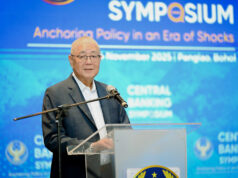E. Visayas leads growth in household spending
By Christine J. S. Castañeda
Researcher
HOUSEHOLD SPENDING last year increased in 16 out of the country’s 18 regions, led by the Eastern Visayas, data released by the Philippine Statistics Authority (PSA) yesterday showed.
The country’s total household spending, with 69.31% share to total expenditures, increased by 6.95% to P5.63 trillion in 2016.
Per capita household spending similarly increased by 5.21% to P54,559.
Among the country’s regions, Eastern Visayas posted the highest growth in per capita Household Final Consumption Expenditure (HFCE) at 8.12% to P42,565.
Central Luzon and Davao Region followed with 7.36% and 6.91% growth rates, respectively.
Other regions that saw acceleration in per capita household spending growth were Ilocos Region (5.5%); Central Visayas (5.3%); Bicol Region (4.8%); MIMAROPA composed of Occidental and Oriental Mindoro, Marinduque, Romblon and Palawan (4.5%); SOCCSKSARGEN composed of South Cotabato, Cotabato, Sultan Kudarat, Sarangani and General Santos City (4.3%); Zamboanga Peninsula (4.2%), Northern Mindanao (3.9%), CAR (3.6%), Cagayan Valley (3.1%), and Caraga in northeastern Mindanao (2.5%).
The Autonomous Region in Muslim Mindanao (ARMM) also saw improvement in per capita HFCE to -1.4% from -5.2%.
Western Visayas (5.3%), the National Capital Region (NCR) or Metro Manila (5.4%) and CALABARZON composed of Cavite, Laguna, Batangas, Rizal and Quezon (4.9%) grew slower than their respective 5.4%, 7.2% and 7.6% paces in 2015.
Negros Island Region, a group composed of Negros Occidental and Oriental that was formed by Executive Order No. 183 of May 29, 2015, was not included in the report.
“Eastern Visayas posted the highest household final consumption expenditure in 2016 at 10.1%,” PSA said in an e-mail.
“Moreover, the population growth of Region VIII slowed down. In addition, Eastern Visayas’ economy recorded 12.4% growth during the same period.”
Ruben Carlo O. Asuncion, chief economist at the Union Bank of the Philippines (UnionBank), said the growth in per capita household spending in Eastern Visayas “may still be the impact of the rehabilitation efforts.”
“It can be momentum brought by efforts to rebuild and consolidate the areas around the region,” he said, referring to reconstruction work after Typhoon Haiyan struck the area in November 2013.
Security Bank Corp. economist Angelo B. Taningco attributed increased spending by households to muted inflation last year.
“One of the main factors that boosted household spending last year was the relatively low consumer price inflation. This was especially true in Eastern Visayas, where inflation was only 1.3%, which is below the inflation rate at the national level of 1.8%,” he said.
In terms of share to total HFCE, NCR, with a 23.3% share, continued to be the highest spending region at P1.311 trillion. It was followed by CALABARZON and Central Luzon at P912.7 billion and P704.3 billion, respectively, contributing 16.2% and 12.5% to total HCFE.
ARMM, with a 1.4% share, was the smallest spender at P76.7 billion.
“I see NCR leading the way still. Since the thrust of the government is to spread opportunities for many more Filipinos, I expect more growth from outside the main economic centers of Metro Manila, Cebu and Davao,” UnionBank’s Mr. Asuncion said.



